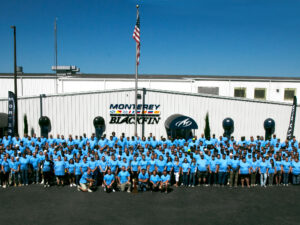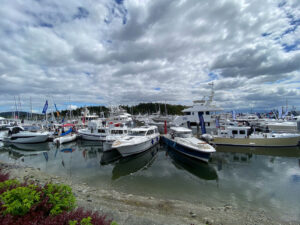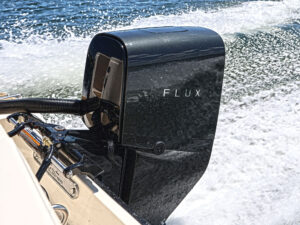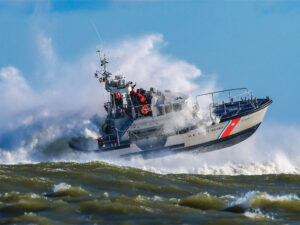The emerald-green waters of Florida’s Government Cut are calm when the engines of a long, slender boat start to rumble. The sound builds until, suddenly, the stiletto-shaped boat slices through the water, ripping long V-wakes that flatten out slightly as the speed increases fantastically. The boat zips through the Cut, looping north into two-foot swells, running along South Beach and finding its groove.
It’s a “go-fast,” a Sunsation 36 XRT, and it is perfectly in its element. So is Wayne Schaldenbrand, who built it. Nope, his boat is built in Michigan, but it’s here today, cutting through open water against the backdrop of Miami glitz.
This may be where modern offshore powerboats were born, but Schaldenbrand caught his bug for it from his grandfather, who hand-built Chris-Crafts and other mahogany treasures, then powered them with one or two of the biggest engines he could.
“My first speedboat ride was in one of those,” Schaldenbrand says. “It probably went 35 miles per hour.” That’s all he needed to launch him and his brother on a career of building and driving fast boats. He was where the heart of this sport still beats steadily with adrenalin and high-octane fuel.
The performance scene slipped beneath the mainstream boating radar the past few years, as the recession and outrageous fuel prices sent people away. But boats like the Sunsation, Formula’s FasTech 353 and the 50 Cigarette Marauder, which turned heads at the recent Miami International Boat Show, prove that performance boats are back. So too does the announcement from Mercury Racing of a new 1,100 hp engine, on the heels of last year’s 1,350 hp V-8. And that’s a good thing. The performance world has always pushed the envelope for all aspects of powerboating.
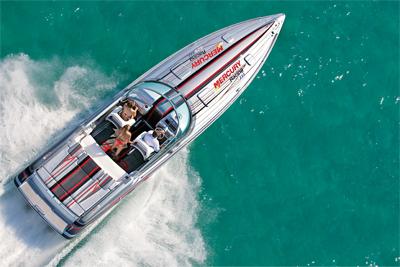
Speed Is Sanctioned
Most boaters associate the offshore performance world with a clip from the opening credits of the 1980s TV show Miami Vice. Sonny Crockett had a Wellcraft Scarab 38. But the need for speed actually traces back to the turn of the 20th century.
The American Power Boat Association formed in 1903 and held its first race on the Hudson River in 1904. Despite holding the race in New York, the scene then revolved around the Michigan boatbuilders, in close proximity to the auto industry in Detroit. Much advancement came from the mind of the famous wood-boat builder Gar Wood, who pushed his designs to get more horsepower on board.
The offshore scene started, as it did for Wayne Schaldenbrand, in the 1950s, with many racers from hydroplane backgrounds; these endurance races ran for hundreds of miles and laid the groundwork for the future.
Offshore performance boating as we know it today emerged through a confluence of events and people in the mid- to late 1950s. Sam Griffith, who worked with yacht broker Richard Bertram, helped found the race that would define the go-fast genre. He, along with boatbuilder Forest Johnson (the father of the famed boating photographer), developed an offshore race between Miami and Nassau, Bahamas.
Miami-Nassau became the premier offshore race in the United States. For a while, it was the only offshore event. Winning it was akin to winning the Indy 500 — and the desire led Bertram to design a hull that changed boating forever.
The inspiration, it turned out, came from a sailboat race. In 1958, designer Ray Hunt’s 23-foot Aqua Hunter, a fiberglass support boat for the 1958 America’s Cup off Newport, Rhode Island, was making waves. The boat had 24 degrees of transom deadrise and lifting strakes, designed to handle the rough waters of offshore sailboat racing. Bertram asked Hunt to design a 30-foot version. The rest is history.
Legend has it that Bertram didn’t want to enter his wooden prototype, named Moppie after his wife, in the 1960 Miami-Nassau race, but Griffith talked him into it. With Griffith at the helm, they charged out into eight-foot swells and blew away every other boat. The second-place finisher, the other Hunt deep-V, Aqua Hunter, came in two hours behind. Most other boats did not finish. From here on, the deep-V ruled the world, and the racing community spent the next several decades figuring out what to do next from Hunt’s hull design.
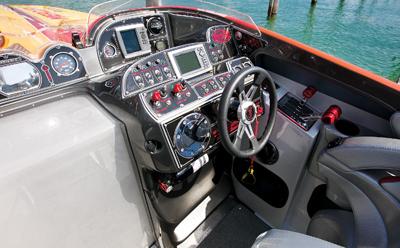
Trial and Error
“During the 1960s, people tried absolutely everything to see what would work,” says Charlie McCarthy, a racer and boatbuilder who helped found the Historic Offshore Race Boat Association (HORBA). He tells the story of one builder running tests in Government Cut and saying, “This is it,” then pulling the hull and realizing the strakes had fallen off!
It was also around this time that a young real estate magnate from Brooklyn, New York, named Don Aronow moved to Miami and fell in love with offshore racing. Through sheer personality and determination, he became one of the top racers and a boatbuilder whose legacy is still felt today.
Aronow hooked up with two designers who would shape his early signature boats, Jim Wynne and Walt Walters. Wynne is the man responsible for bringing to market the other great innovation of the late 1950s, the stern-drive. Wynne had worked for Carl Kiekhaefer developing outboards with Charlie Strang, who originally pitched the stern-drive to Kiekhaefer, who rejected it. Strang and Wynne further pursued the idea, and when Wynne left the outboard company, he developed the first stern-drive in his garage and sold it to Volvo Penta, which released it in 1959 as the Aquamatic Drive.
Wynne and Walters helped Aronow design boats for his first company, Formula. McCarthy remembers walking into Aronow’s shop in a desolate area, one of only two buildings standing on 188th Street. This stretch would become home to many go-fast builders and be nicknamed “Thunderboat Row.”
Aronow had a 23-foot Formula inside that he had named the Cigarette. McCarthy would learn the name stemmed from a reported rum-running boat that ran in New York during Prohibition. Aronow had Wynne design the boat to compete in the 1963 Miami-Key West Race, one of the many competitions that emerged. Aronow himself would go on to win many races.
Eventually, the standard racing boat became the 24-degree, deep-V hull around 30 feet long, powered by twin gasoline stern-drives and staggered for weight distribution and to place the props closer together. The boats had a three-man crew — the driver, the throttle man and the navigator.
Aronow sold Formula to Thunderbird during this era and started a new company called Donzi. Then he sold Donzi and started Magnum Marine, where he teamed with designer Harry Schoell. To insiders, Magnums were game-changers.
“The defining boat,” says Allan Brown, a veteran racer, “was the 28 Magnum designed by Harry Schoell.” Aronow cut it down and sold it as the 27 Magnum, but to “Brownie” and others, the hull lived on through hundreds of copies.
By 1969, Aronow had sold off Magnum Marine and started racing a 32-foot Cary he also named the Cigarette. Aronow raced that boat to the 1969 World Championship and promptly retired from racing to start what became the defining brand of the go-fast world. You can guess the name.
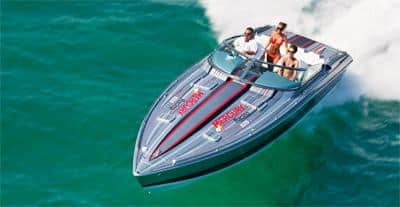
Bad Boys Were Good Business
Miami Vice lives on beyond its time. Its portrayal of go-fast boats brought a new image to the scene. Like with Harley-Davidson motorcycles, enthusiasts flocked to brands like Cigarette and Scarab for the outlaw image. Doctors, lawyers and businessmen could get behind the wheel of a go-fast boat and feel like a bad boy.
Charlie McCarthy calls the decade of the 1970s the “golden era” of offshore performance boats. “Anyone could buy a boat off the street and be competitive,” he says. “If you were able to grit your teeth and hang on, you could win.”
Thunderboat Row became the epicenter of the race scene. Bertram was still heavily involved in racing and producing boats, and builders such as Formula, Donzi, Magnum, Apache, Cigarette, Tempest and, later, Cougar were going strong.
Innovations from the racing side began to spill into recreational boatbuilding, as pleasure-boat builders learned more and more. Pleasure boaters took to the idea of going fast, and performance boats gained traction in the public eye. In the 1980s, they’d gain notoriety for different reasons, though.
The trouble was, the outlaw image was real. Mainstream sponsors started abandoning the offshore race world, scared off by its drug-money affiliations. The world of performance boats also took a major hit when Don Aronow was murdered. It remained unsolved for a long time, spurring rumors of a mob hit or that Aronow was a victim of the Miami drug wars.
The deep-V racing scene took another hit at the hands of fast catamarans. “They just destroyed racing for a while,” says Allan Brown, because they won every race.
The cats could go significantly faster than the V-hulls in calm water. With their appearance, and with sponsorship opportunities dwindling, offshore racing went from a unified group under the APBA to several splinter organizations.
Go-fasts continued to have a strong recreational following, but the era of the classic offshore deep-V race seemed past.
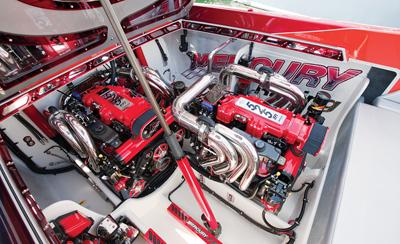
Gambling on Poker Runs
Nothing could be further from the truth, though. Builders like Fountain, Formula, Baja and Donzi kept performance racing alive while bringing the recreational end to new heights in the 1990s and early 2000s.
Poker runs replaced racing as the focal point of the scene and represented a sea change in performance boating from the early years. While some old racers decry this development, poker runs may save the go-fast boat.
Most races field about 20 to 25 entrants; a major poker run will get 150 to 200 boats. Participants run — not race — to five different checkpoints and draw a playing card at each one. The person with the best hand at the end wins. “It’s the same type of thrill,” Lipschutz says, “but nobody argues over who wins.”
In the old days, you had to rebuild everything after every race, and a typical recreational performance stern-drive lasted 20 or 30 hours before breaking down. But today’s engines hold up, and the boats are built with lighter cored construction.
Indeed, Cigarette, Formula, Sunsation, Outer Limits and others all survived the recession. Baja, Donzi and Fountain have been resurrected under American Marine Holdings. and Reggie Fountain started a new company, RF Boats (which stands for “real fast,” not Reggie Fountain). Building is a different game. Of production go-fasts, Sunsation’s Schaldenbrand says, “Those days are about 80 percent gone.”
Schaldenbrand estimates he will build 12 36 XRTs this year. Overall, his company will build about 45 boats, down from around 80 in the early 2000s.
With or without poker runs, performance boats will always be around. Someone is going to get behind the wheel of a boat and make it run as fast as possible. As Schaldenbrand explains, “I was born with it. It’s in my blood somehow.”
Or, as Reggie Fountain once said, “It takes a lot of money to win offshore races, but as long as there’s somebody out there racing, I’m going to be out there kicking their asses.”
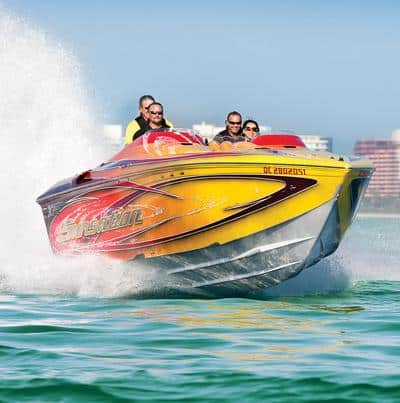
Game-Changing Design
The biggest change in fast, deep-V hulls in the past 20 years has been the popularization of stepped hulls. Steps date back to the early days of powerboats in the 1900s, but they didn’t start to gain mainstream acceptance until builders like Reggie Fountain popularized them in the 1990s.
Phil Lipschutz, a cigarette dealer in Miami and a veteran racer, explains the allure of stepped hulls: “You can’t go if your propellers are in the air. With twin steps, a boat will lie in the water and hook up so much better. It’s faster and easier on the engines.”
Stepped-hull boats go 10 mph faster than a conventional V-hull with the same power, and they ride level. Early designs with large 21/2 -inch steps proved unpredictable and could catch and spin bow to stern. But most builders have honed the steps down to 11/4 inches, getting the same performance results with more stability.
The twin-stepped hull is now the dominant form in modern performance boats, such as the Sunsation 36 XRT. “We siphoned everything we could from high-end catamarans and aviation,” Wayne Schaldenbrand says. With twin 525s, the 36 XRT hits around 95.5 mph.
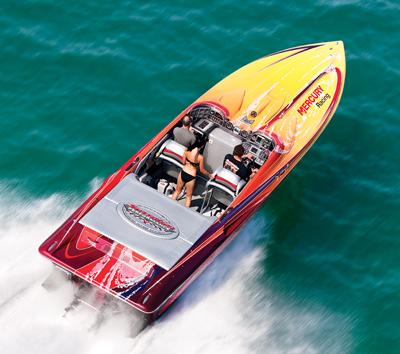
Carl Kiekhaefer & Mercury Racing
One of the great ironies in boating is that Carl Kiekhaefer, the man who dismissed the idea of a stern-drive in the 1950s, became one of its biggest proponents in the 1970s. Kiekhaefer is famous for his revolutionary Mercury outboards, always pushing them to go faster at his mysterious testing center in Florida known as Lake X.
Kiekhaefer sold his outboard business to Brunswick in the 1960s and left the company in 1969. In the early 1970s, he went on to form Kiekhaefer Aeromarine Motors, which specialized in marine racing sterndrives. He applied the same demand for excellence there.
“One of the key guys he had was a kid named Richie Powers,” recalls Charlie McCarthy of the Historic Offshore Race Boat Association. “They’d go through engine after engine, blowing them out and tweaking them until they got 625 hp out of a 496 block.” When they finally got it, Powers asked Kiekhaefer, “Can I go home now? It’s Christmas.”
When Carl passed away, his son Fred took on the company and eventually sold it to Brunswick, which renamed it Mercury Racing. Fred Kiekhaefer is still very much involved as president of Mercury Marine.


